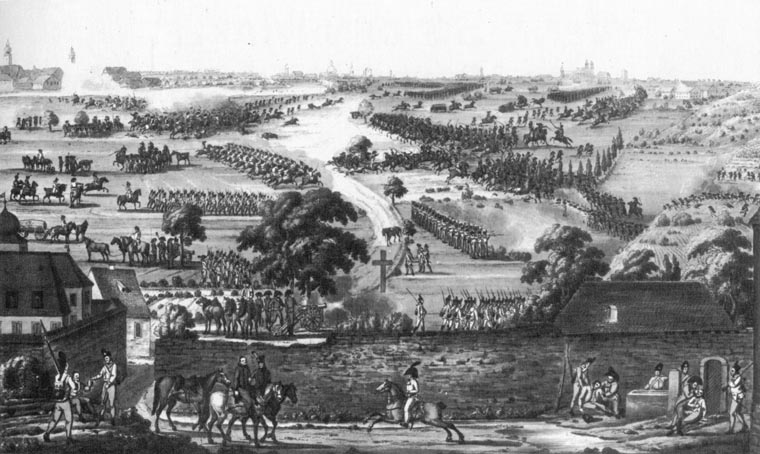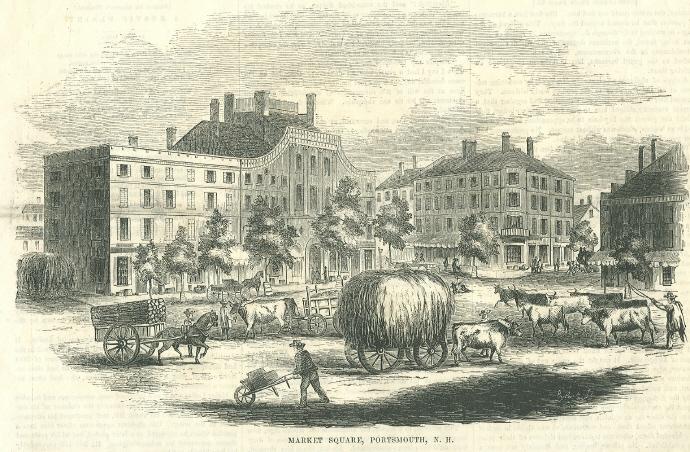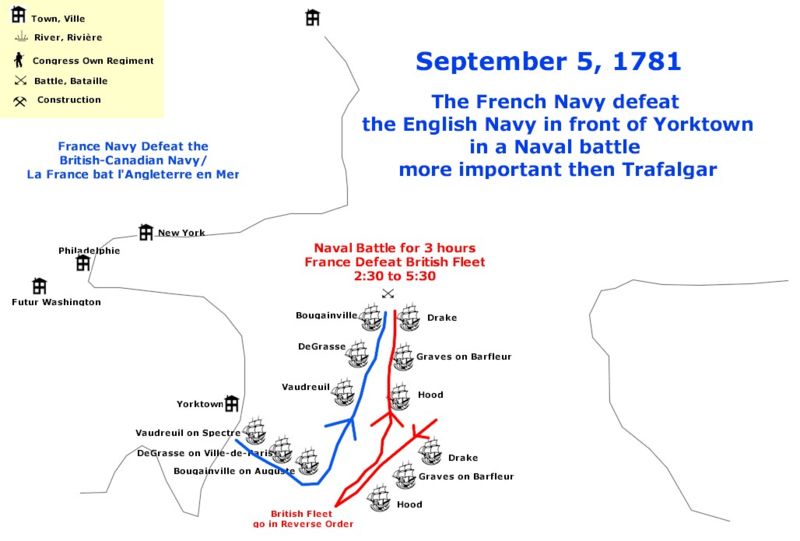|
Jean-Jacques Ambert
Jean-Jacques Ambert (30 September 1765 – 20 November 1851) commanded a French division in several engagements during the French Revolutionary Wars. He embarked on a French ship of the line during the American Revolutionary War and saw several actions. At the start of the French Revolutionary Wars he commanded a battalion and thereafter enjoyed fast promotion. He led a division in action at Kaiserslautern in 1793, Kaiserslautern in 1794, Luxembourg, Handschusheim, and Mannheim in 1795, and Kehl in 1796. His career later suffered eclipse because of his association with two French army commanders suspected of treason. He spent much of the Napoleonic Wars commanding a Caribbean island, clearing his name, and filling interior posts. His surname is one of the names inscribed under the Arc de Triomphe. Early career Ambert was born on 30 September 1765 at Saint-Céré in what later became the department of Lot. His parents were Jacques Ambert and Marianne Rouchon. In 1780 he shippe ... [...More Info...] [...Related Items...] OR: [Wikipedia] [Google] [Baidu] |
Saint-Céré
Saint-Céré (; Languedocien: ''Sant Seren'') is a commune in the Lot department, southern France. Its population is 3,414 (2019). The commune includes within its borders the castle of Saint-Laurent-les-Tours, where the artist Jean Lurçat lived and worked for many years, and from which he operated a secret radio for the French Resistance. The castle still houses a collection of his works. Geography Location The town is located in the centre of a small metropolitan area, in the Quercy, northeast of the Causse de Gramat and west of Segala, between Lacapelle-Marival and Bretenoux, in the valley of the Bave, tributary of the Dordogne river, and on the northern edge of the Limargue. It is the city-centre of the urban unit of Saint-Céré. Located at the crossroad of the routes to Limousin, Auvergne and Quercy, Saint-Céré is a sought after place to stay due to its location and an excellent point of departure for many walks and excursions in the Haut-Quercy. Hydrography The Ba ... [...More Info...] [...Related Items...] OR: [Wikipedia] [Google] [Baidu] |
Légion D'Honneur
The National Order of the Legion of Honour (french: Ordre national de la Légion d'honneur), formerly the Royal Order of the Legion of Honour ('), is the highest French order of merit, both military and civil. Established in 1802 by Napoleon Bonaparte, it has been retained (with occasional slight alterations) by all later French governments and regimes. The order's motto is ' ("Honour and Fatherland"); its seat is the Palais de la Légion d'Honneur next to the Musée d'Orsay, on the left bank of the Seine in Paris. The order is divided into five degrees of increasing distinction: ' (Knight), ' (Officer), ' (Commander), ' (Grand Officer) and ' (Grand Cross). History Consulate During the French Revolution, all of the French orders of chivalry were abolished and replaced with Weapons of Honour. It was the wish of Napoleon Bonaparte, the First Consul, to create a reward to commend civilians and soldiers. From this wish was instituted a , a body of men that was not an order of ... [...More Info...] [...Related Items...] OR: [Wikipedia] [Google] [Baidu] |
General Of Brigade
Brigadier general or Brigade general is a military rank used in many countries. It is the lowest ranking general officer in some countries. The rank is usually above a colonel, and below a major general or divisional general. When appointed to a field command, a brigadier general is typically in command of a brigade consisting of around 4,000 troops (four battalions). Variants Brigadier general Brigadier general (Brig. Gen.) is a military rank used in many countries. It is the lowest ranking general officer in some countries, usually sitting between the ranks of colonel and major general. When appointed to a field command, a brigadier general is typically in command of a brigade consisting of around 4,000 troops (four battalions). In some countries, this rank is given the name of ''brigadier'', which is usually equivalent to ''brigadier general'' in the armies of nations that use the rank. The rank can be traced back to the militaries of Europe where a "brigadier general", ... [...More Info...] [...Related Items...] OR: [Wikipedia] [Google] [Baidu] |
Chef De Bataillon
Major (commandant in certain jurisdictions) is a military rank of commissioned officer status, with corresponding ranks existing in many military forces throughout the world. When used unhyphenated and in conjunction with no other indicators, major is one rank above captain, and one rank below lieutenant colonel. It is considered the most junior of the field officer ranks. Background Majors are typically assigned as specialised executive or operations officers for battalion-sized units of 300 to 1,200 soldiers while in some nations, like Germany, majors are often in command of a company. When used in hyphenated or combined fashion, the term can also imply seniority at other levels of rank, including ''general-major'' or ''major general'', denoting a low-level general officer, and ''sergeant major'', denoting the most senior non-commissioned officer (NCO) of a military unit. The term ''major'' can also be used with a hyphen to denote the leader of a military band such as i ... [...More Info...] [...Related Items...] OR: [Wikipedia] [Google] [Baidu] |
Portsmouth, New Hampshire
Portsmouth is a city in Rockingham County, New Hampshire, United States. At the 2020 census it had a population of 21,956. A historic seaport and popular summer tourist destination on the Piscataqua River bordering the state of Maine, Portsmouth was formerly the home of the Strategic Air Command's Pease Air Force Base, since converted to Portsmouth International Airport at Pease. History American Indians of the Abenaki and other Algonquian languages-speaking nations, and their predecessors, inhabited the territory of coastal New Hampshire for thousands of years before European contact. The first known European to explore and write about the area was Martin Pring in 1603. The Piscataqua River is a tidal estuary with a swift current, but forms a good natural harbor. The west bank of the harbor was settled by European colonists in 1630 and named Strawbery Banke, after the many wild strawberries growing there. The village was protected by Fort William and Mary on what is now ... [...More Info...] [...Related Items...] OR: [Wikipedia] [Google] [Baidu] |
Louis-Philippe De Vaudreuil
Louis-Philippe de Rigaud, Marquis de Vaudreuil (18 April 1724 – 14 December 1802) was second in command of the French squadron off America during the American Revolutionary War. Biography Early life Louis-Philippe Rigaud de Vaudreuil was born into a family with a rich political and military tradition. His grandfather, Philippe de Rigaud de Vaudreuil, and his uncle Pierre de Rigaud de Vaudreuil de Cavagnal, were both governors of Canada; the latter was its last governor, surrendering Montreal to the British in 1760. Another uncle, Pierre-François de Rigaud, fought with Montcalm at the Battle of Oswego. His father, also named Louis-Philippe de Rigaud de Vaudreuil, was an admiral of the French Navy: he saved Desherbiers de l'Etenduère at the Second battle of Cape Finisterre while commanding the 74-gun ''Intrépide'' and was in charge of the Navy in North America in 1747. His younger brother, Louis de Rigaud de Vaudreuil, was also a Navy officer. They served together ... [...More Info...] [...Related Items...] OR: [Wikipedia] [Google] [Baidu] |
Saint Lucia
Saint Lucia ( acf, Sent Lisi, french: Sainte-Lucie) is an island country of the West Indies in the eastern Caribbean. The island was previously called Iouanalao and later Hewanorra, names given by the native Arawaks and Caribs, two Amerindian peoples. Part of the Windward Islands of the Lesser Antilles, it is located north/northeast of the island of Saint Vincent (Antilles), Saint Vincent, northwest of Barbados and south of Martinique. It covers a land area of with an estimated population of over 180,000 people as of 2022. The national capital is the city of Castries. The first proven inhabitants of the island, the Arawaks, are believed to have first settled in AD 200–400. Around 800 AD, the island would be taken over by the Kalinago. The French were the first Europeans to settle on the island, and they signed a treaty with the native Caribs in 1660. England took control of the island in 1663. In ensuing years, England and France fought 14 times for control of the island, ... [...More Info...] [...Related Items...] OR: [Wikipedia] [Google] [Baidu] |
French Ship Pluton (1778)
''Pluton'' was a ''Scipion'' class 74-gun French ship of the line built at Rochefort. Career ''Pluton'' took part in the Battle of Martinique on 17 April 1780, under La Marthonie. Albert de Rions took command, and captained her at the Battle of Martinique on 29 April 1781, at the Battle of the Chesapeake on 5 September 1781, at St. Kitts on 24–25 January 1782, and at the Battle of the Saintes The Battle of the Saintes (known to the French as the Bataille de la Dominique), also known as the Battle of Dominica, was an important naval battle in the Caribbean between the British and the French that took place 9–12 April 1782. The Brit ... on 12 April. She was renamed ''Dugommier'' in 1797 and seems to have seen little further active service. She was broken up in 1805. Notes and references Notes References Bibliography * * * {{DEFAULTSORT:Pluton (1778) Ships of the line of the French Navy Scipion-class ships of the line Ships built in France 1778 ship ... [...More Info...] [...Related Items...] OR: [Wikipedia] [Google] [Baidu] |
Lot (department)
Lot (; oc, Òlt �l is a department in the Occitanie region of France. Named after the Lot River, it lies in the southwestern part of the country and had a population of 174,094 in 2019.Populations légales 2019: 46 Lot INSEE Its is ; its subprefectures are and [...More Info...] [...Related Items...] OR: [Wikipedia] [Google] [Baidu] |
Names Inscribed Under The Arc De Triomphe
The following is a list of the 660 names inscribed under the Arc de Triomphe, in Paris. Most of them represent generals who served during the French First Republic (1792–1804) and the First French Empire (1804–1815). Underlined names signify those killed in action. Additionally, the names of specific armies are listed, grouped together by the four compass facades of the arch: North (northern France, lower Rhine, Netherlands), East (Central Europe, Switzerland, Italy), South (Mediterranean Europe, Egypt, southern France) and West (Pyrenees, western France, notable units). Related list: Battles inscribed on the Arc de Triomphe. File:Paris Arc de Triomphe inscriptions 2.jpg, Northern pillar Armies of northern France, the lower Rhine and the Netherlands. File:Paris Arc de Triomphe inscriptions 3.jpg, Eastern pillar Armies of Central Europe, Switzerland and Italy. File:Paris Arc de Triomphe inscriptions 7.jpg, Southern pillar Armies of Mediterranean Europe, Egypt and souther ... [...More Info...] [...Related Items...] OR: [Wikipedia] [Google] [Baidu] |
Napoleonic Wars
The Napoleonic Wars (1803–1815) were a series of major global conflicts pitting the French Empire and its allies, led by Napoleon I, against a fluctuating array of European states formed into various coalitions. It produced a period of French domination over most of continental Europe. The wars stemmed from the unresolved disputes associated with the French Revolution and the French Revolutionary Wars consisting of the War of the First Coalition (1792–1797) and the War of the Second Coalition (1798–1802). The Napoleonic Wars are often described as five conflicts, each termed after the coalition that fought Napoleon: the Third Coalition (1803–1806), the Fourth (1806–1807), the Fifth (1809), the Sixth (1813–1814), and the Seventh (1815) plus the Peninsular War (1807–1814) and the French invasion of Russia (1812). Napoleon, upon ascending to First Consul of France in 1799, had inherited a republic in chaos; he subsequently created a state with stable financ ... [...More Info...] [...Related Items...] OR: [Wikipedia] [Google] [Baidu] |
Ship Of The Line
A ship of the line was a type of naval warship constructed during the Age of Sail from the 17th century to the mid-19th century. The ship of the line was designed for the naval tactic known as the line of battle, which depended on the two columns of opposing warships maneuvering to volley fire with the cannons along their broadsides. In conflicts where opposing ships were both able to fire from their broadsides, the opponent with more cannons firingand therefore more firepowertypically had an advantage. Since these engagements were almost invariably won by the heaviest ships carrying more of the most powerful guns, the natural progression was to build sailing vessels that were the largest and most powerful of their time. From the end of the 1840s, the introduction of steam power brought less dependence on the wind in battle and led to the construction of screw-driven wooden-hulled ships of the line; a number of purely sail-powered ships were converted to this propulsion mech ... [...More Info...] [...Related Items...] OR: [Wikipedia] [Google] [Baidu] |





